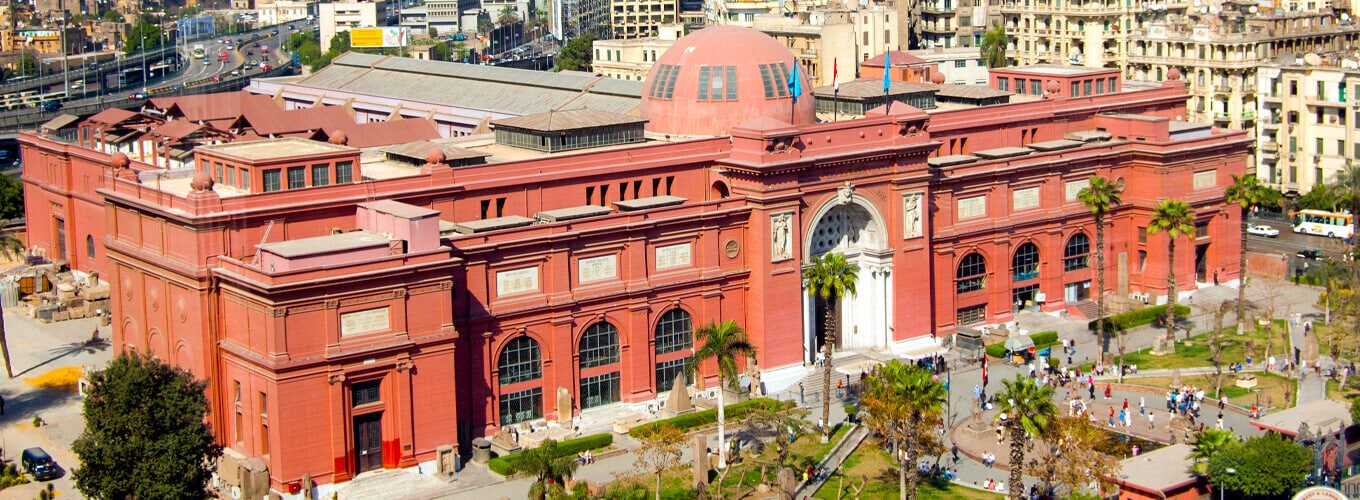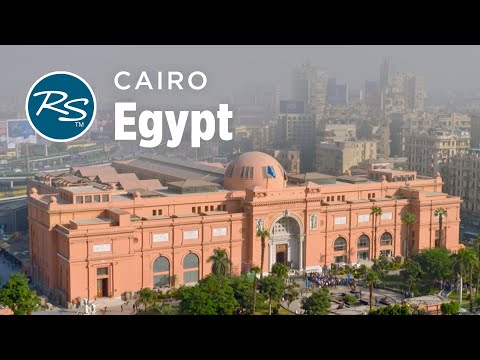In the heart of Cairo, the Egyptian Museum is a gateway to ancient Egypt’s world. It has over 120,000 artifacts from many years. This famous museum lets visitors travel back in time to learn about an old and powerful culture.
But what secrets do these artifacts hold? What do they tell us about the Egyptians’ lives, beliefs, and achievements? Let’s dive into the mysteries of Ancient Egypt History at the Egyptian Museum.
Key Takeaways
- The Egyptian Museum in Cairo has the biggest collection of ancient Egyptian artifacts, with over 120,000 items.
- Visitors can dive into ancient Egypt’s history. They’ll see exhibits that cover thousands of years and reveal the Egyptians’ lives and culture.
- The museum’s design and its huge collection make it a top spot for those interested in ancient Egypt.
- The Egyptian Museum is key in keeping the legacy of one of the world’s oldest and most important cultures alive.
Unraveling the Mysteries of Ancient Egypt
A Journey Through Time at the Egyptian Museum
The Egyptian Museum in Cairo takes you on a thrilling trip through ancient Egypt. It shows you the different dynasties and time periods that made this civilization great. You’ll see everything from the Neolithic period (4500-3000 BCE) to the Greco-Roman era (332 BCE-642 CE).
Interactive exhibits and displays show the history, culture, and amazing architecture of ancient Egypt. You’ll learn about the hieroglyphics and how the Nile River was key to their success.
At the museum, you can dive deep into Egyptology. This is where scholars and fans have tried to solve mysteries for years. The museum has lots of artifacts, like big sculptures and detailed jewelry. These show what life was like, what people believed in, and what they achieved back then.
“The Egyptian Museum is a true treasure trove, a window into the captivating world of ancient Egypt. It’s a must-visit destination for anyone seeking to understand the enduring legacy of this legendary civilization.”
If you love history, art, or just want to learn more about the past, this museum is for you. It’s a journey that changes how you see things. Get ready to be wowed by the beauty and smartness of ancient Egypt. You’ll discover secrets that have amazed people for thousands of years.
The Egyptian Museum: A Treasure Trove of Antiquities
In the heart of Cairo, the Egyptian Museum is a key part of ancient Egypt’s history and culture. It opened in 1902 and has the biggest collection of pharaonic artifacts in the world. This collection has over 170,000 items from the Pre-Dynastic Period to the Graeco-Roman Era (c. 5500 BC – AD 364).
At the Egyptian Museum, you can travel back in time. You’ll see over 100,000 masterpieces, from tiny relics to huge sculptures. It’s a great chance to learn about ancient Egypt’s fascinating past.
| Ticket Prices | Permitted Items | Prohibited Items |
|
|
|
The museum houses famous artifacts such as the Menkaure Triads, the granite statue of the child Ramesses II and the god Horus. These, along with many others, allow visitors to explore the rich history and culture of ancient Egypt.
The Egyptian Museum in Cairo is a great place for those interested in ancient Egyptian civilization. It houses a vast collection, modern technology and engaging exhibits. Visitors leave with a deeper love for the enduring legacy of this ancient culture.
Iconic Artifacts and Pharaonic Wonders
The Egyptian Museum in Cairo houses many famous Pharaonic artifacts and wonders, and gives visitors a special look into the rich history and culture of ancient Egypt.
Egyptian Museum: A Gateway to Ancient Civilizations
The Egyptian Museum in Cairo is a major entry point to ancient Egyptian culture. It houses the world’s largest collection of ancient Egyptian artifacts. This place allows visitors to explore the deep culture of this amazing civilization.
The museum is 13,600 square meters in size and has more than 100 exhibition halls. Each hall displays different parts of ancient Egyptian life.
The design of the museum is unique. It has elevated rooms, upper balconies and ceiling openings. This leaves visitors in awe. The museum was started in the late 19th century and is the first national museum in the Middle East.
Now, some of the artifacts are moving to the new Grand Egyptian Museum in Giza. But the Egyptian Museum is still a must-see. It is ideal for those who want to learn about ancient civilizations and enjoy museum exhibitions.
Explore the Dynasties and Time Periods
Uncovering the Rich History of Ancient Egypt
The Egyptian Museum takes you on a journey through ancient Egypt’s history. It covers from the Neolithic period to the Greco-Roman era. You’ll see how the Nile River shaped Egypt’s culture and economy.
Start with the Early Dynastic Period, when Egypt was first united under pharaohs. Then, visit the Old Kingdom, where the pyramids were built. The museum also shows the First Intermediate Period, the Middle Kingdom, and the New Kingdom.
These periods show Egypt’s ups and downs. You’ll learn about the Third Intermediate Period, the Saite and Late Period, and the Greco-Roman Period. Each period tells a unique story of ancient Egypt.
At the Egyptian Museum, you’ll see ancient Egypt from its start to its legends. It’s a journey through time that changes how you see history.
The Grandeur of Ancient Egyptian Architecture
The Egyptian Museum takes you on a journey through ancient Egyptian architecture’s grandeur. It’s known for its amazing artifacts and replicas. These show the engineering and art skills of an ancient civilization.
The museum’s main attraction is the pyramids. These huge monuments still amaze people today. You can see the detailed work and size of these structures. The museum also has temples and other ancient buildings that show the Egyptians’ creativity.
The museum tells the story of these architectural wonders. It houses a huge statue of Ramses II from over 3,200 years ago. There is also the famous solar boat. These pieces showcase the beauty of ancient Egyptian architecture.
Today, the museum mixes old and new architecture. The Jameel Center in Cairo combines old Mamluk styles with modern designs. This shows how ancient styles can be used in today’s buildings.
The museum works with groups like CulturVator – Art D’Egypte to keep ancient Egyptian architecture alive. They have events like the “Forever is Now” exhibition. This show features art from around the world near the Great Pyramids of Giza.
Visitors see the beauty of ancient Egyptian architecture as they walk through the museum. They see the pyramids, temples, and how old designs are used in new buildings. The museum’s collection shows the lasting impact of this ancient civilization on architecture around the world.
Immersive Exhibits and Interactive Displays
The Egyptian Museum in Cairo takes you on an amazing journey into ancient Egypt. It has immersive exhibits and interactive displays. These bring the ancient culture to life.
The Grand Egyptian Museum will soon be fully open and will be even more interactive. It covers a huge 500,000 square meters. It will show 51,000 archaeological artifacts, with over 50,000 already fixed up. You can explore timelines, multimedia shows, and hands-on activities. These let you dive deep into Egyptology and the ancient artifacts on show.
| Exhibit | Details |
| Tutankhamun: The Immersive Exhibition |
|
| Grand Egyptian Museum |
|
These exhibits at the Egyptian Museum in Cairo and the Grand Egyptian Museum will amaze you. They offer a deep dive into the wonders of ancient Egyptian civilization.

Egyptian Museum: A Must-Visit Destination
The Egyptian Museum in Cairo is a treasure for those who love ancient Egypt’s history and culture. It has the world’s biggest collection of pharaonic artifacts. This museum lets you travel back in time and dive deep into Egyptology.
Since 1902, the Egyptian Museum has been the oldest archaeological museum in the Middle East. It has over 120,000 priceless items from ancient Egypt. You’ll see mummies, royal jewels, big sculptures, and detailed hieroglyphics. These show the greatness and beauty of ancient Egypt.
| Ticket Prices | Museum Details |
| Regular Admission: 450 EGP (approx. $14.50 USD)
Mummy Room Access: Additional 100 EGP Photography Pass: Additional 300 EGP |
Opened in 1902
No Air Conditioning Some Exhibits Moved to Grand Egyptian Museum |
The museum may not have modern comforts like the Grand Egyptian Museum in Giza. But it gives a special experience that takes you back in time. Its open design lets you see many displays at once. This creates a feeling of wonder and discovery.
Going to the Egyptian Museum is a must for anyone into the ancient world. It’s great for history buffs, art fans, or those just curious about the past. This museum gives a memorable experience that will leave you amazed by ancient Egypt’s lasting legacy.
Plan Your Visit to the Egyptian Museum
Visiting the Egyptian Museum in Cairo is a must for travelers. It’s perfect for those who love the Pharaohs or want to dive into Egypt’s culture. Planning your trip makes sure you have a great time.
The museum is open every day from 9:00 AM to 5:00 PM. The last ticket is sold at 4:00 PM. You can buy tickets at the entrance. Seniors, children, and students get discounts.
You can take photos of the amazing artifacts. But, please don’t use flash. Also, follow the rules about videos and commercial use.
| Ticket Type | Price (in Egyptian Pounds) |
| Adult | 200 LE |
| Senior (over 60 years old) | 100 LE |
| Student | 100 LE |
| Child (under 12 years old) | 50 LE |
Plan your trip to the museum ahead of time. Here are some tips:
- Arrive early to avoid crowds and long queues at the entrance.
- Wear comfortable shoes and dress modestly to respect the cultural norms.
- Bring a water bottle and snacks, as there are limited food options within the museum.
- Familiarize yourself with the museum’s layout and plan your route to make the most of your visit.
- Consider joining a guided tour to gain a deeper understanding of the artifacts and their historical significance.
By planning your visit to the Egyptian Museum in Cairo, you’ll be ready to explore ancient Egypt’s treasures. You’ll make memories that last a lifetime.
Conclusion: Embracing Egypt’s Timeless Legacy
The Egyptian Museum in Cairo is a key part of ancient Egypt’s lasting legacy. It’s a place where history, art, and culture come together. Visitors can dive deep into the history of this fascinating civilization.
By visiting the museum, people can feel the charm of ancient Egypt. They can see the famous bust of Nefertiti and the wonderful treasures. The museum displays more than 5,000 years of Egyptian history, highlighting their creativity and skill.
The museum is more than just a place to see old things. It’s a center for learning, research, and celebrating culture. It has labs for preserving artifacts, keeping them safe for the future.
Read our related articles:


